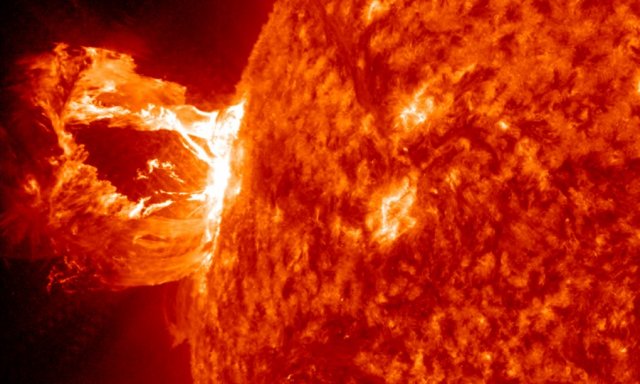
Everybody loves a good “whodunit?” How else could you explain the number of television shows with the prefix “CSI”? So when a study in Nature identified a previously unknown (and very large) spike in carbon-14 around the year 774 AD, it raised a lot of eyebrows. This radioactive isotope of carbon is created when energetic particles from beyond the Earth transform atmospheric nitrogen to a form of carbon with two neutrons more than the most common isotope.
Nobody could think of a historical account of unusual phenomena in the heavens that might have triggered a surge in 14C production, and something like this should have been hard to miss. So when a college student from UC-SD found a record of a “red crucifix” in the skies over Britain in that year, Nature published his note.
The original report, published by researchers from Nagoya University in Japan, involved analysis of Japanese cedars. Because the production of carbon-14 in the atmosphere varies over time, researchers often pursue records of that variability to increase the accuracy and precision of radiometric carbon dating. Tree rings provide one of those records.
When the researchers sifted through their data, they discovered the unusually high amount of carbon-14 in rings from 774 and 775 AD, and did some thinking about what could potentially have caused it. There were a couple of possibilities to consider. One was a solar flare, which can launch charged particles into Earth’s atmosphere that generate carbon-14. Another was a nearby supernova, which releases large amounts of gamma radiation.
No increase in carbon-14 has been found to coincide with documented supernovae in 1006 or 1054 AD, so in order to explain the spike in 774 AD, a supernova would have to be either many times larger or much closer than those. But such an event would have been impossible to ignore—the “guest star” that appeared in 1006 was brighter than Venus— and no record of it was known.
So what about a large solar flare? They put that down as unlikely, too, as their calculations showed it would take a flare at least a thousand times larger than anything we knew about to do the job. Again, the effects would have been remarkable, with otherworldly aurorae and a deadly thrashing of the ozone layer.
So the source of the radioactive carbon was a mystery, but one that was cleared up last week. It turns out they did the math wrong. A pair of researchers from Washburn University and the University of Kansas published a comment in Nature pointing out that the solar flare calculations included a rather fundamental error. Working backwards from the intensity required to produce the right amount of carbon-14 in Earth’s atmosphere, they mistakenly calculated the total size of the event as if the flare was emitted in all directions from the Sun, forming an expanding bubble of charged particles. In reality, solar flares erupt in directional jets, as can be seen in this NASA video.
Obviously, that brings down the required size of the event considerably. Still, it leaves it some 20 times larger than the 1859 Carrington Event—the largest solar flare recorded from the Sun. Events that large have been observed on other stars, so it’s possible our Sun is capable of it, as well.
While the lack of a historical record for an event like that is still conspicuous, the revised calculation also reduces the impact it would have on the ozone layer. The Japanese group believed it would be large enough to cause a mass extinction event, but the Kansas researchers disagree. “The results are consistent with moderate biological effects: reduction of primary photosynthesis in the oceans and increased risk of erythaema and skin cancer, but no major mass-extinction level effects as implied earlier,” they wrote.
A bit of self-correction
This is the self-correcting nature of science at work. Not everything gets caught by peer review, and mistakes get published. That’s not as big of a problem as it could be because scientists are, as a rule, a distrustful lot. Unlike lesser mortals, their eyes don’t glaze over when they reach the methods section of a paper. (Okay, sometimes they do.) When the Kansas researchers found a number that didn’t seem to make sense, they sat down and worked it out.
Sometimes, this kind of scrutiny results in the critic realizing that the, while surprising, a result was apparently correct. From there, they might devise a way to investigate or test it in another context. In other instances, like this one, an error is discovered and corrected so everyone can get on with the business of figuring stuff out.
As for whatever appears to have occurred in 774, all options are back on the table. If there was a significant event, and it was caused by a massive solar flare, it would behoove us to learn all we can about it. While the effects back in 774 could have been a bit unpleasant, folks then didn’t rely on digital infrastructure and a global communication network, so it wouldn't have been as disruptive.
Nature, 2012. DOI: 10.1038/nature11695, 10.1038/nature11123 (About DOIs).
reader comments
50